|
Limitar tu búsqueda
[+–] Compilador o editor
[+–] Editorial
[+–] Fecha
[+–] Formato
[+–] Idioma
[+–] Tipo de documento
[+–] Tipo de recurso
[+–] Classification
|

|
|
The reproductive health in the social security
The Mexican Social Security Institute, as a part of the National Health System, endeavors to observe the social security principies, i.e.: universality, solidarity, integrity, equity and efficiency; assisting the beneficiaries with opportuneness, quality and kindness; assuming, since fifty three years ago, the responsibiiity of looking over the health of more than fifty per cent of the population...
|
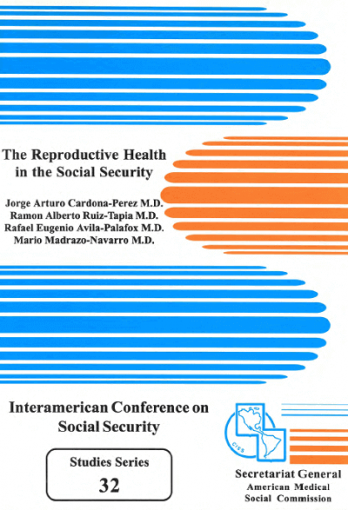
|
|
|
|

|
|
II High Level Conferences Cycle: Social Security in America towards the End of the XX Century
In this book compiles the papers presented during the Second High-Level Conference Cycle, titied: Social Security in America towards the End of the XX Century, which has as its main theme Social Security Reforms and Economic and Social Policies. Such event was held at the seat of the CISS, on September 2, 3, and 4, 1996, and its main objectives were to promote the scientific and multidisciplinary...
|
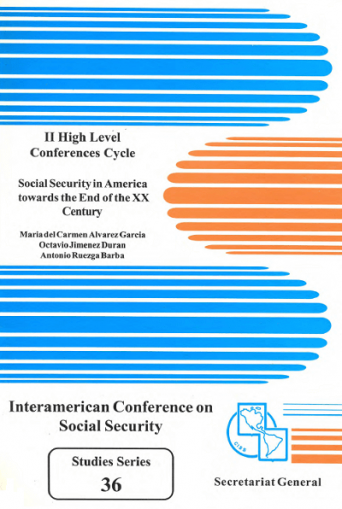
|
|
|
|

|
|
Mujer y seguridad social en América
La importancia global del tema de la condición de la mujer y la urgente necesidad de eliminartodas las barreras que aún existen para su participación igualitaria, en el proceso social, económico, cultural y político de su país o su comunidad están fuera de toda discusión. Por ello, es innegable la validez de la existencia de los múltiples instrumentos internacionales en los que se ha reiterado el...
|

|
|
|
|

|
|
Social security pensions and retirement decisions in Mexico
Using Mexican cohort data for 1991-2000 this article examines the relationship between retirement decisions —the transition from work to labor market inactivity— and social security (contributive) pensions in less developed countries. The available large time series also makes possible to examine how a financial crisis that took place in 1995 has affected retirement incentives. In most Latin...
|

|
|
|
|

|
|
A simple poverty scorecard for Mexico
This study uses Mexico's 2008 National Household Survey of Income and Expenditure to I construct an easy-to-use scorecard that estimates the likelihood that a household has income below a given poverty line. The scorecard uses ten simple indicators that field workers can quickly collect and verify. Poverty scores can be computed on paper in the field in about five to ten minutes. The scorecard's...
|
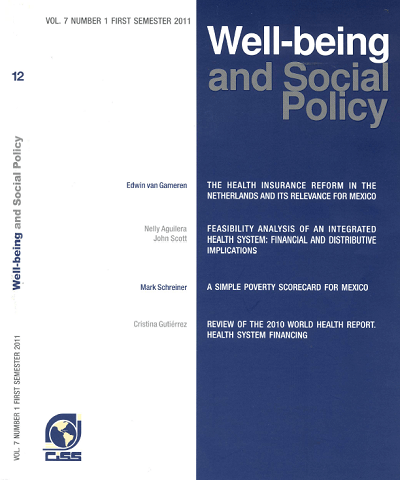
|
|
|
|

|
|
Social security in United States of America
This monograph describes the health and social security situation in the United States.
|

|
|
|
|

|
|
Natural disasters and poverty in Latin America: welfare impacts and social protection solutions
The Inter-American Conference on Social Security (CISS) and the United Nations Development Programme (UNDP) Office in Mexico jointly organized the conference “Natural Disasters in Latin America: Welfare Impacts and Social Protection Solutions” held in Mexico City in January 2010. The main objectives of the conference were to improve the understanding of (i) how natural disasters affect...
|
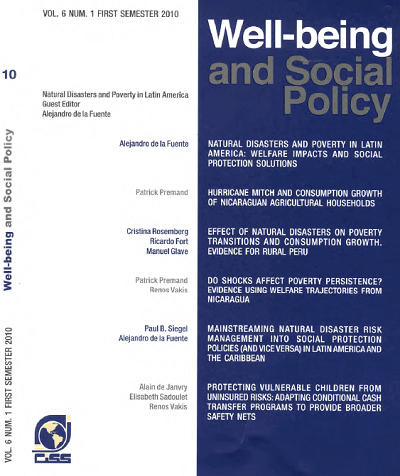
|
|
|
|

|
|
Are loan guarantees effective? The case of mexican government banks
Mexican Government’s Banks offer loan guarantees to private banks in order to spur credit directed to non-financial small and medium sized firms and this policy is examined here. Application of representative data to the comparative static analysis of the guarantee-use decision suggests that these schemes, as currently designed, are justifiable from an economic viewpoint. However, there is some...
|
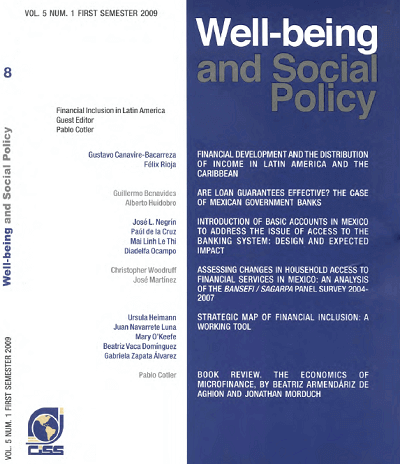
|
|
|
|

|
|
Introduction of basic accounts in Mexico to address the issue of access to the banking system: design and expected impact
This article presents the Mexican experience with the introduction of basic transaction accounts. Basic accounts are relatively cheap simple banking products with restricted functionality targeted at social groups that have limited access to transaction accounts. In Mexico, basic payroll accounts and accounts for the general public were introduced. By law, these products must be offered by all...
|
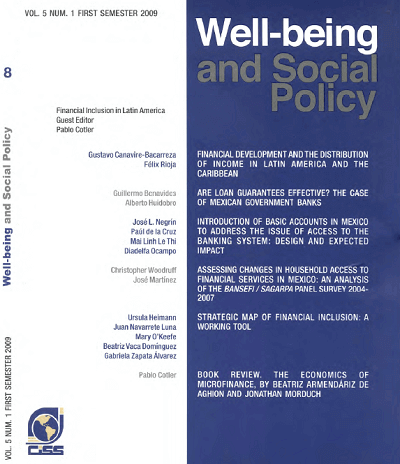
|
|
|
|

|
|
Assessing changes in household access to financial services in Mexico: an analysis of the BANSEFI/SAGARPA panel survey 2004-2007
In March 2004, BANSEFI and SAGARPA began a project to examine the impact on households I of the Program to Strengthen the Popular Credit and Savings Sector (Programa de Fortalecimiento del Sector de Ahorro y Crédito Popular), which was designed to help non-bank financial intermediaries to abide by the Ley de Ahorro y Crédito Popular (LACP), passed by the Mexican Congress in 2001. During the...
|
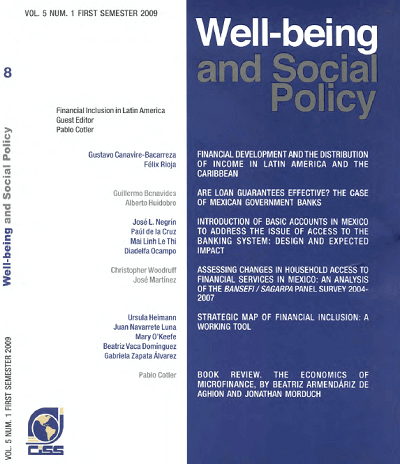
|
|
|
|

|
|
Strategic map of financial inclusion: a working tool
Various circumstances make difficult the rigorous study of processes, strategies and impact of V the efforts of financial inclusion and penetration, either at the academie level, in the public policy area or in companies and organizations of financial services industry. The central problem in Mexico has been the lack of a unified agreement on the definition and the low comprehension level of the...
|
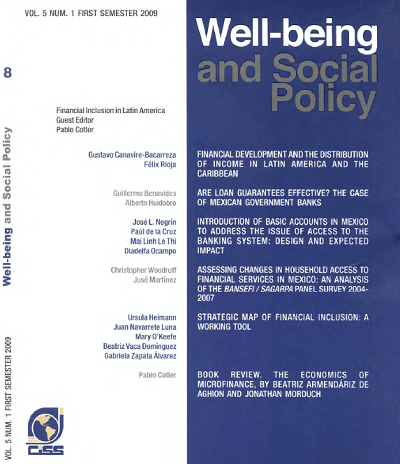
|
|
|
|

|
|
Book review. The economics of microfinance, by Beatriz Armendáriz de Aghion and Jonathan Morduch
The book by Armendáriz and Morduch focuses on how microfinance institutions work, what has been their impact and whether they are financially sustainable. For such purpose the book can be divided—from my viewpoint—into six sections. The first describes the environment of imperfect information that surrounds credit transactions and the consequences that this entails. First the authors define in a...
|
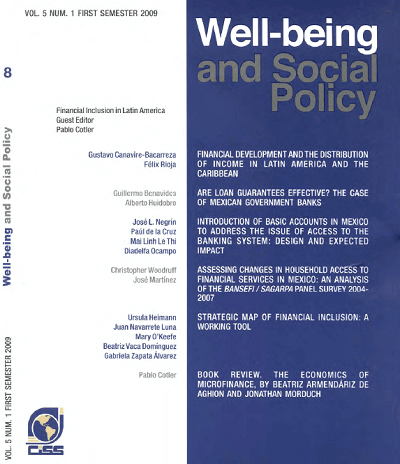
|
|
|
|

|
|
Toward closing the evaluation gap: lessons from three recent impact evaluations of social programs in Latin America and the Caribbean
Despite recent growing demand from funders and governments, rigorous impact evaluations in Latin America and the Caribbean remain the exception rather than the rule. Many commissioned impact evaluations are methodologically weak, and thus only marginally useful in assessing the impact of social interventions. Other impact evaluations feature strong research methodologies at their conception, but...
|

|
|
|
|

|
|
Evaluating rural electrification projects: methodological approaches
In recent years, the international community has expanded efforts in program evaluation to improve the accountability of development projects. This paper presents approaches to implementing state of the art evaluations in rural electrification projects, taking into account specific challenges that researchers face in such interventions. II suggests an approach to assess impacts before an...
|
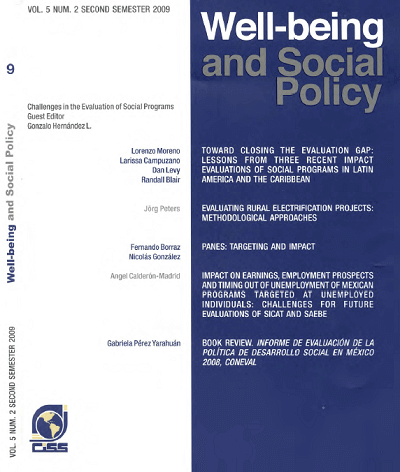
|
|
|
|

|
|
PANES: targeting and impact
This research paper intends to quantifit targeting performance in terms of the efficiency of the 1 National Plan for Social Emergency Assistance (PANES) implemented in Uruguay between 2005 and 2007 and determine its impact on relevant issues such as school attendance, child labor and the labor market. For this analysis , we used 2006 and 2007 Continual Household Survey (ECH) data.
Our outcomes...
|

|
|
|
|

|
|
Impact on earning, employment prospects and timing out of unemployment of mexican programs targeted at unemployed individuals: challenges
his paper presents estimates of the impact of programs for unemployed workers on the performance of program beneficiaries in Mexico. We emphasize the significance of applying methodologies capable of avoiding statistical bias attributable to unobserved variables when measuring the impact on earnings and allowing to us properly estimate unemployment duration and work status after exiting from...
|
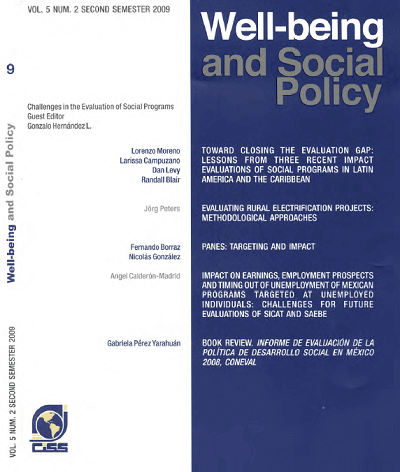
|
|
|
|

|
|
Book review. Informe de evaluación de la política de desarrollo social en México 2008, CONEVAL
The Evaluation Report on Social Development Policy in Mexico was published by the National Council for Social Development Policy Evaluation (CONEVAL) in 2008. The Council is one of the constituting elements of the new institutional framework to evaluate the public sector performance, particularly social development policies that were put in place mostly during the first decade of this century....
|

|
|
|
|

|
|
Hurricane Mitch and consumption growth of nicaraguan agricultural households
There is little micro-evidence on the persistence of natural disasters' welfare impacts. This paper assesses the effect of Hurricane Mitch on consumption of Nicaraguan agricultura) households. Mitch occurred in October 1998. Pre-post data is obtained from a nationally representative panel collected in 1998 and 2001. An additional survey was fielded in 1999 for households from the panel affected...
|
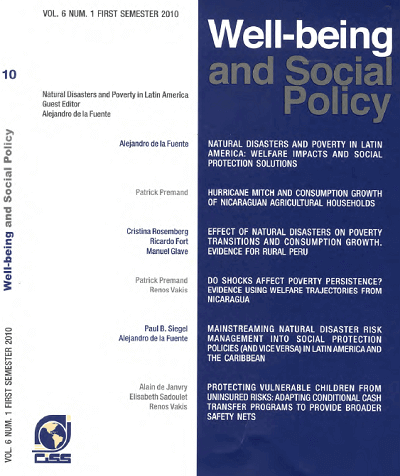
|
|
|
|

|
|
Feasibility analysis of an integrated health system: financial and distributive implications
The document presents spending projections and projections of the distributive incidence for an Integrated Health System under three basic scenarios: status quo, a two pillar scheme (financed through general taxes and private spending) and a three pillar scheme (financed through general taxes, social security contributions and private spending). By presenting these simulations, the study enhances...
|
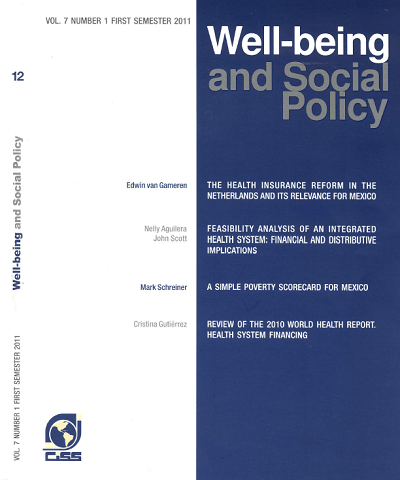
|
|
|
|

|
|
Effect of natural disasters on poverty transitions and consumption growth. Evidence for rural Peru
Natural hazards, an increasingly important phenomenon, have a direct impact at regional and household level. The growing incidence and persistence of natural events are strongly linked to increasing vulnerability of households and communities in developing countries. Previous socioeconomic vulnerabilities may exacerbate the impact of a specific event, making more difficult the process of...
|
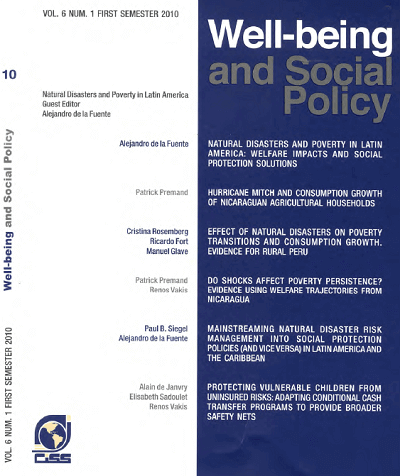
|
|
|
|
|